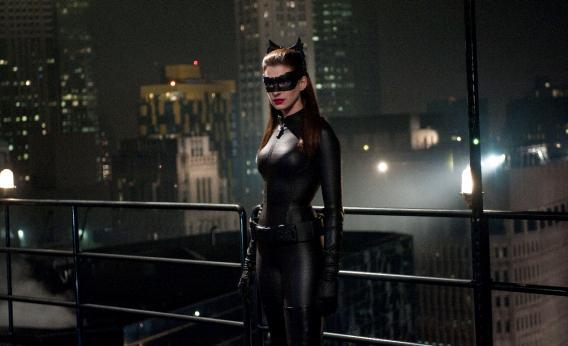When director Christopher Nolan and his brother and screenwriter Jonathan Nolan revealed that The Dark Knight Rises was inspired by A Tale of Two Cities, the Internet lit up with speculation. Would Batman growl about Gotham’s best of times, and worst of times?
Now that you’ve had a chance to see the movie, we can round up a few of the ways—explicit and otherwise—that The Dark Knight Rises draws on Dickens’ work.
Major spoilers ahead.
The most direct reference to A Tale of Two Cities comes at the end of the film, at Bruce Wayne’s (would-be) burial. Even on an IMAX screen you might not be able to make out the leather-bound book that Gordon holds in his hands, but it is none other than Dickens’ novel of the French Revolution. Rather than quote the book’s famous opening passage, however, Gordon flips to the end, to the novel’s less well-known last lines*:
It is a far, far better thing that I do, than I have ever done; it is a far, far better rest that I go to than I have ever known.
Gordon’s selection of this passage as Batman’s eulogy is quite apt. First of all, the lines in the book represent the last thoughts of the character Sydney Carton as he prepares to make the ultimate sacrifice for his loved ones and city—a sacrifice just like the one Batman makes. At the end of the novel, Carton manages to switch places with the character Charles Darnay as Darnay faces execution. As he does so, he expresses faith in his city, just like the faith Batman expresses for Gotham again and again throughout the Batman trilogy. Here’s the passage that comes just before those last lines:
I see a beautiful city and a brilliant people rising from this abyss, and, in their struggles to be truly free, in their triumphs and defeats, though long to come, I see the evil of this time and of the previous time of which this is the natural birth, gradually making expiation for itself and wearing out.
Carton, like Bruce Wayne, is also an orphan, which brings us to another Dickensian thread of The Dark Knight Rises: The movie is teeming with orphans. Not only is there Bruce Wayne, but the final chapter of the trilogy introduces the new character of John Blake, an orphan who understands Batman thanks to their shared experience of losing their parents. Blake frequently checks back at the orphanage where he was raised, which is underfunded (presumably, in part, because of the movie’s greedy Dickensian capitalists, with their Dickensian names—the weaselly Stryver was likely inspired by the Tale of Two Cities character of the same name).
Some of these orphans, as they’re lured into becoming thieves and criminals, evoke another Dickens novel, Oliver Twist. And Selina Kyle (Anne Hathaway), though the movie never reveals her past, resembles the Artful Dodger from Twist: Both characters have been taught by an impoverished city to fend for themselves by developing the skills of a master pickpocket, and both are defined by their ability to skirt responsibility in order to save themselves: The Dodger lets Twist go on trial for the theft he committed, just as Kyle sells Batman out to Bane to repay her debts. We seem to get a glimpse of her past when she bonds with a young orphan by giving him a pointer about how to steal an apple—she says that, like the Dodger, he should make sure to always have an escape plan.
But the scenes that most boldly evoke A Tale of Two Cities—along with, of course, the novel’s basis in the history of the French Revolution—are the scenes of its vengeful populist uprising. As in A Tale of Two Cities, The Dark Knight Rises depicts a mob that thirsts for the blood of the rich who have neglected and exploited them. The poor drag the rich from their homes and put them on trial before kangaroo courts. In each revolution, the trials are decided more by the clamor of the crowd than by any due process, and there’s little hope for the defendants.
Of course, as Slate’s Dana Stevens points out in her review, the trials in Nolan’s movie also have a Kafkaesque quality. This is seen in the way that Gordon and other prisoners are given only the hopeless and darkly comic decision of “exile” or “death … by exile.”* (Elsewhere, the movie’s references reach back even further, all the way to Robin Hood.) But in the way The Dark Knight Rises demonstrates both a desire for social justice and a fear of what that can actually look like in the hands of a mob, it owes its greatest debt to Dickens.
*Correction, July 22, 2012: This article originally suggested that the passage from A Tale of Two Cities was read by Alfred; Gordon reads the passage. Additionally, this article misquoted the (false) choice Dr. Jonathan Crane gives to Gotham’s prisoners as “death” or “death by exile”; Crane offers “exile” or “death … by exile.”
Previously
Christopher Nolan’s Favorite Shot, and What It Means
